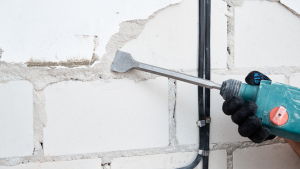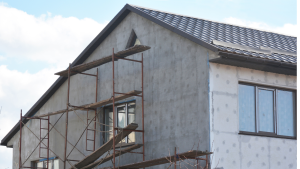When should you fix stucco cracks if you own a property and have noticed that your stucco walls are starting to split? When does maintenance become a necessity?
Cracks in stucco are rather frequent. Anyone whose walls are made of stucco will tell you that they appear to be surrounded by shots. If you have stucco, you should know how cracks form and when they need to be repaired.
The following guide covers the causes of stucco cracks, how to fix them, and when to fix them.
Types of Stucco Cracks
In stucco walls, fractures may take many different forms. How you fix stucco cracks will depend on the many causes of these fractures.
Here are the signs that can help you determine the kind of stucco cracks you have.
Hairline Cracks: The typical width of these fissures is 1/16 of an inch or less. You’ll most often see these kinds of cracks. There are several causes for its emergence. Most often occur in newly constructed houses because plaster settles and shifts during construction. Hairline fractures may sometimes be caused by shifting foundations, aging wood, and building activities.
Foam Trim Cracks: Sometimes cracks will also appear in the foam trim used on stucco. If you notice cracking in this area, you can tell that fiberglass mesh tape wasn’t used to install the foam trim. Cracking will eventually result from expansion and contraction over time.
Spider Cracking: Your stucco’s cracks have a spiderweb-like appearance, hence the name. This is a sign that the base coat needs more time to cure. This might result from too much water in the mixture, a hasty drying process, or an improper application day temperature.
Pattern Cracking: You can see pattern-following wall cracking. It often manifests on your stucco as a grid of horizontal and vertical lines. The lath installation process had issues, which resulted to this cracking. It probably needs to be correctly fastened, which will cause cracks to grow over time.
Diagonal Cracking: As their name suggests, these fractures are diagonal in appearance and often appear around doors and windows. They move as a result of them because of seismic shifts in the foundation. You should start by fixing any cracks on your stucco that are wider than others.
When Should Stucco Cracks Be Fixed
In light of this, when should you fix any stucco cracks you notice?
The short answer is, “as soon as you can.”
Even if you’ve already seen a little crack, you should take care of it straight soon. Even if it may be minor right now, it might eventually grow and create greater problems in the future. Filling it in right now will halt the crack in its tracks.
In addition to this, you must make sure your house is secure. Water may enter stucco cracks if there are any, leading to mold growth and moisture issues. The earlier you patch the damage, the better since they are tough to fix if you don’t find them in time.
How to Repair Cracks
Depending on how the crack developed, there are different methods for fixing stucco.
- If the crack is just a hairline, it is safe to plug it in to stop it from expanding.
- If the crack is diagonal or patterned, you will need to put in more effort or hire professionals to assist you in fixing the issue.
It’s pretty easy to repair a hairline crack. Numerous items that will aid in filling it in are available for purchase at your neighborhood hardware shop. If you need clarification on the one you ought to get, consult the employees there.
DIY
You may use acrylic caulk, which is the most popular product, to close up any gaps.
- The crack must be widened to about a quarter-inch wide before any debris must be removed with a wire brush.
- Use a caulk gun and the mixture to fill up the crack afterward.
- Give the caulk 24 hours to dry completely before painting over it with water-based paint.
When to Contact Experts
Pattern cracks need the lath under the stucco to be fixed or replaced. It follows that to get entry, the stucco must be taken off. After the lath has been securely attached, new stucco will need to be put on top of it.
It’s likely that there is a problem with your home’s foundation if there are any large or diagonal cracks. In these situations, you’ll need to hire experts to take care of the foundation first; otherwise, you’ll just notice more, worsening cracks over time. Call a professional to check your foundation and determine how it can be fixed.
How to Stop Stucco from Cracking in the Future
If your stucco has any cracks, you should make sure you can stop any further cracks from forming.
How can you guarantee you won’t need to perform additional stucco repair work in the future?
You must apply fresh stucco if you want the greatest effects since it depends on how it is done.
Lath must be installed properly to prevent cracks as well.
Additionally, there are installation techniques that will minimize fractures. Inquire about control joints, casing beads, and corner beads from your building crew. They help lessen the pressure on the stucco, which lowers the chance of cracking overall.
Conclusion
You can stop any significant issues from occurring if you exercise caution and closely monitor your stucco. Treat tiny cracks as soon as you see them to prevent them from spreading and creating further issues for you. Dealing with stucco cracks as soon as you see them is always the best action.
Call a professional to look at them if they turn out to be bigger or more problematic than you anticipated.
By doing this, you can maintain the quality of your stucco for many years.



